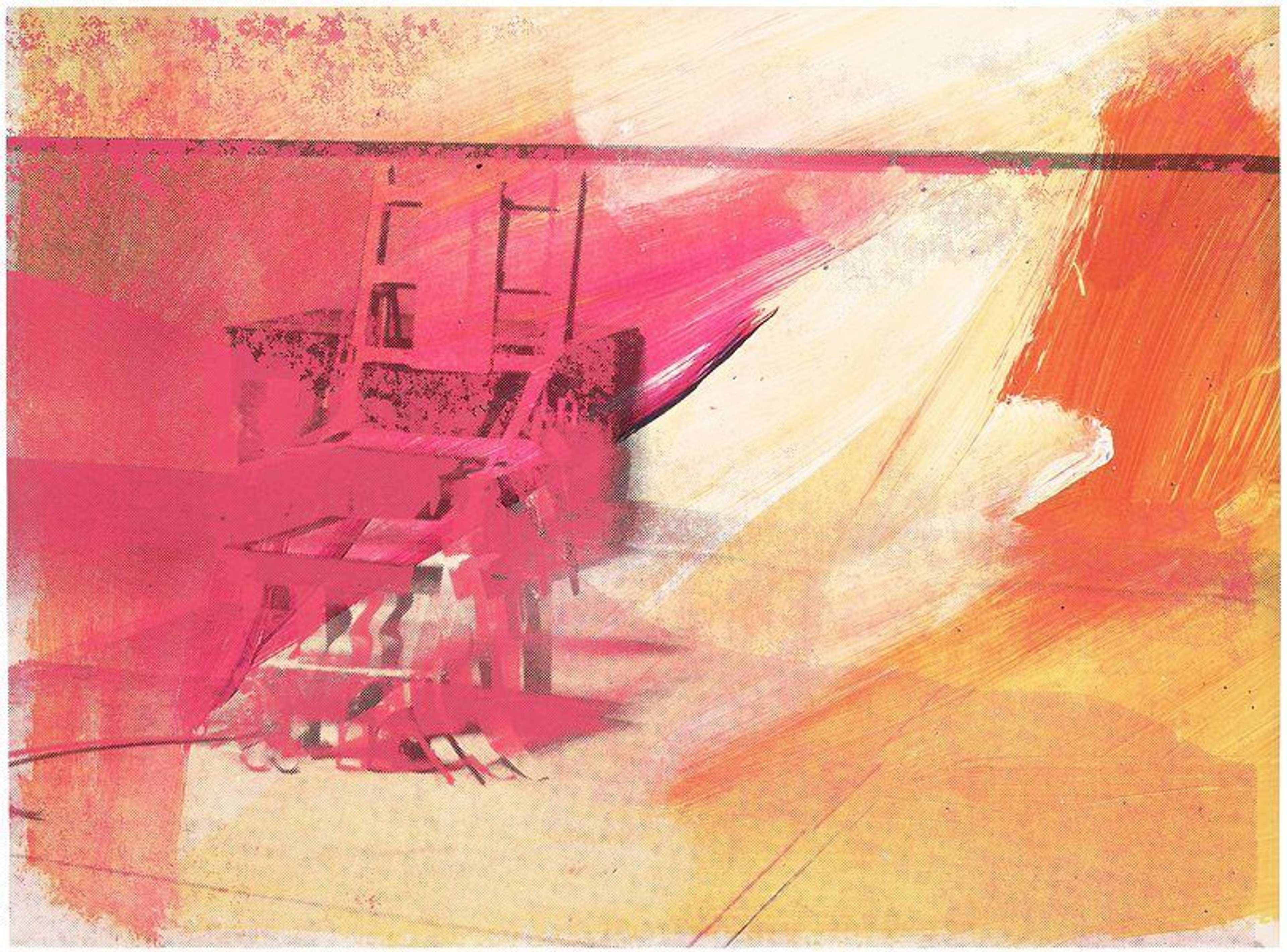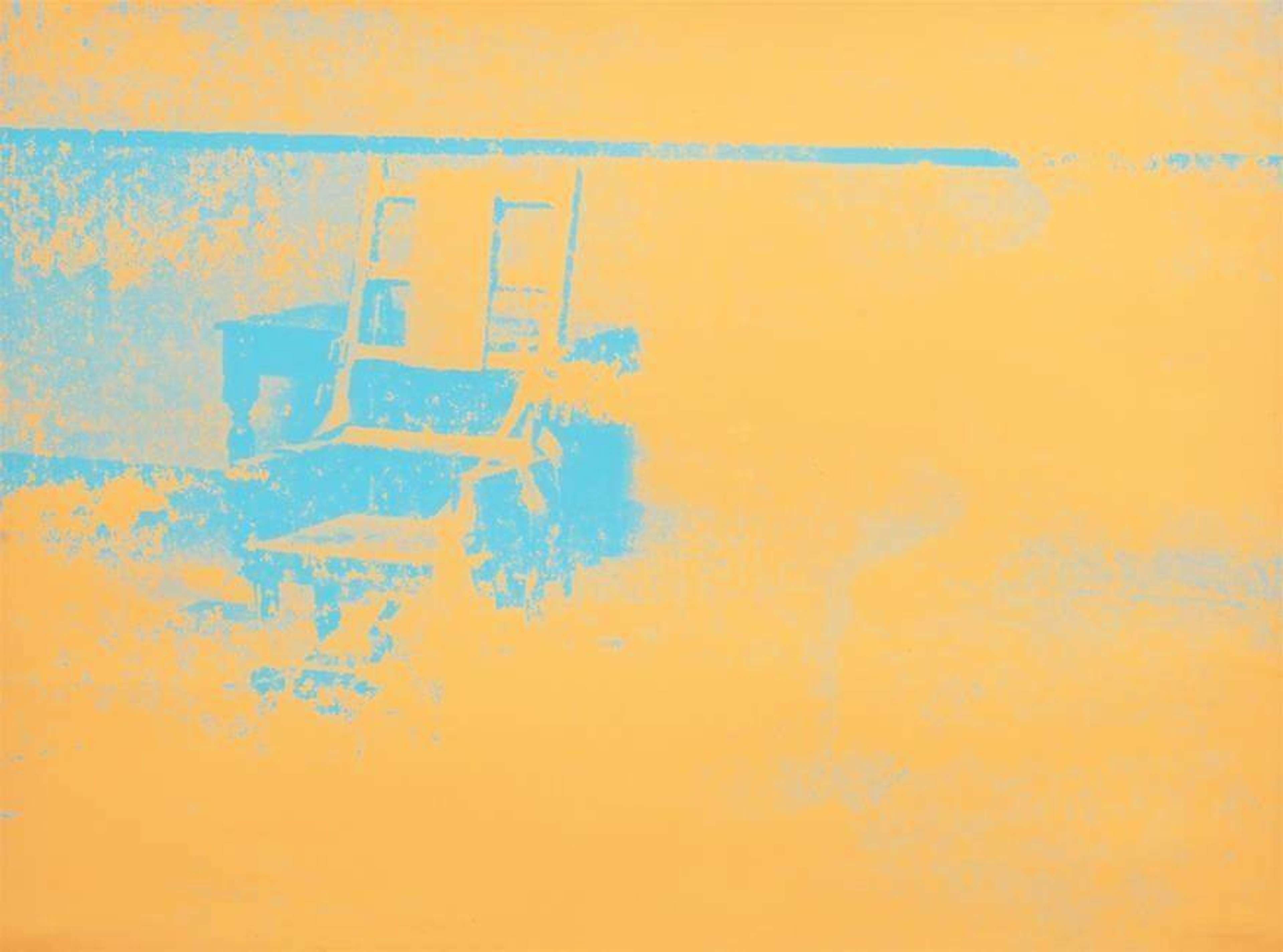 Electric Chair (F. & S. II.78) © Andy Warhol 1971
Electric Chair (F. & S. II.78) © Andy Warhol 1971
Interested in buying or selling
Andy Warhol?

Andy Warhol
487 works
In Electric Chair, Andy Warhol imbues the execution technique with Pop sensationalism. The series appropriates the infamous image of the electric chair which claimed the lives of Julius and Ethel Rosenberg, like a macabre time capsule of this moment in American history.
Electric Chair is part of Warhol's seminal Death And Disaster series.
 Electric Chair (F. & S. II.75) © Andy Warhol 1971
Electric Chair (F. & S. II.75) © Andy Warhol 1971Born out of his Death And Disaster series, Electric Chair speaks to Warhol's fascination with the images spread by mass media. Within this seminal series, Warhol repeated popular images to show how print culture can diminish the seriousness of the news being captured.
Warhol represented the Electric Chair for over ten years.
 Image © Christie's / Little Electric Chair © Andy Warhol 1964-5
Image © Christie's / Little Electric Chair © Andy Warhol 1964-5First represented in 1964, Warhol was clearly fascinated with the Electric Chair for a long period in his career. Seven years later, Warhol returned to the haunting subject to create this limited series of 10 screenprints.
The series is based on a 1953 press photograph.
 Image © Creative Commons / Julius and Ethel Rosenberg 1950
Image © Creative Commons / Julius and Ethel Rosenberg 1950The image that characterises the Electric Chair series was the original press photograph from the documentation of Julius and Ethel Rosenberg's execution. Convicted and sentenced to death for spying on behalf of the Soviet Union, the Rosenberg's high profile execution was at the fore of mass media when Warhol appropriated the image in true Pop style.
The series attests to Pop Art's indelible tie to public affairs.
 Electric Chair (F. & S. II.79) © Andy Warhol 1971
Electric Chair (F. & S. II.79) © Andy Warhol 1971Whether he was representing the Hollywood icons of his time like Marilyn Monroe, political leaders like Mao, or highlighting the fate of the Rosenbergs, Warhol always based his art on the hot topics of his time.
The series has an unconventionally macabre appeal.
 Electric Chair (F. & S. II.78) © Andy Warhol 1971
Electric Chair (F. & S. II.78) © Andy Warhol 1971Electric Chair is quite the departure from Warhol's bright and glamorous portraits of celebrities. Despite his use of bright colour in some of the prints in this series, Warhol's Electric Chair prints are distinctly eerie. With atmospheric lighting and a largely empty composition, Warhol transformed the simple scene of the electric chair into one which was loaded with violent potential.
The series explores mass media's role in emptying imagery of meaning.
 Electric Chair (F. & S. II.74) © Andy Warhol 1971
Electric Chair (F. & S. II.74) © Andy Warhol 1971With his over-saturation and repetition of this mass-circulated image, Warhol emphasised the media's role in trivialising cataclysmic events. This was the sole purpose of the Death And Disaster series, of which Warhol himself remarked: "The more you look at the same exact thing, the more the meaning goes away, and the better and emptier you feel."
The last execution by electric chair in NYC was in 1963.
 Electric Chair (F. & S. II.76) © Andy Warhol 1971
Electric Chair (F. & S. II.76) © Andy Warhol 1971Shortly before Warhol made his first Electric Chair print, the last execution by electric chair was performed in New York. In certain US states, however, the chair is still used to send convicted criminals to death today.
The prints have a ghostly and haunting quality that is not seen in mass-circulated imagery.
 Electric Chair (F. & S. II.81) © Andy Warhol 1971
Electric Chair (F. & S. II.81) © Andy Warhol 1971Particularly in Electric Chair (F. & S. II.81), Warhol's application of coloured paint charges the execution room with a macabre energy. A sweep of light rises from the bottom of the chair towards the top right of the composition, like a spirit escaping the torturous tool of execution.
The series critiques the unrelenting representation of tragedy, death, and violence in the media.
 Electric Chair (F. & S. II.80) © Andy Warhol 1971
Electric Chair (F. & S. II.80) © Andy Warhol 1971By printing his Electric Chair over and over again, it seems that even Warhol became desensitised to the violent potential of the chair. In true Pop fashion, Warhol's practice therefore mimics the unsentimental nature of mass media.
The series encapsulates Warhols pursuit of capturing American culture.
 Electric Chair (F. & S. II.83) © Andy Warhol 1971
Electric Chair (F. & S. II.83) © Andy Warhol 1971By immortalising what would have been considered 'low' popular culture into a work of art, Electric Chair embodies the ethos of Pop and Warhol's leading position in the movement. Today, the series appears like a time capsule, and a poignant reminder of the media's ever-present role in our lives.
